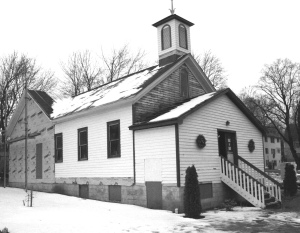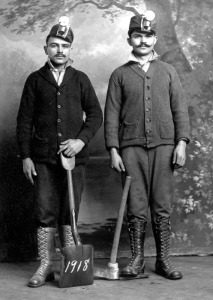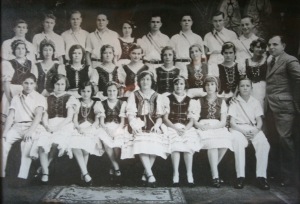A Place to Gather
While researching the history of the Hungarian Reformed Church of Franklin, New Jersey, I couldn’t help but think back to the 70s television show, “Little House on the Prairie,” and see the parallel roles the church building itself played in both communities. Despite being separated by about 30 to 40 years in time period, both societies relied on this central community fixture to serve beyond its function as a gathering place for religious worship and education. In both it was also the community meeting hall, the community school, and the focal point of any celebration.
“Little House on the Prairie,” based on the writings of Laura Ingalls Wilder, described the life and times of the homestead pioneer in the 1870s and 1880s. In the adapted television series, viewers saw a small rural community on the frontier lands of Kansas. The church building served many functions to this small community of people trying to survive the trials and tribulations of a pioneer life far away from “civilized” societies back east. It was simple necessity and reason that caused this one building to serve so many different functions for these people.
For the Hungarians living in northern New Jersey and working in the zinc mines in the early 1900s life was very similar. Life working in the the mines was brutal. The living conditions were sparse. And given the fact that life in New Jersey was culturally very different from life back in Hungary, many Hungarians struggled to acclimate.
Like the pioneers of, “The Prairie,” most of the workers had left their homes and families in Eastern Europe to journey west for a chance at a new life. They sought a new existence and possible fortune in a land of opportunity. The land and its customs were foreign. The best chance for solace and safety was found in uniting as a cultural group, trying to keep their faith and culture alive while attempting, at the same time, to assimilate into their new surroundings. The people who had journeyed so far were as much pioneers as the homesteaders farther out west in the prairie decades earlier.
Finding Community
Besides serving to its congregations spiritual needs, the Hungarian Reformed Church of Franklin, New Jersey served as the cultural hub of Hungarians. In his book, “The Story of an Immigrant Group in Franklin, New Jersey,” János Makár writes about the many different cultural activities that were organized out of the church. Celebrations, men’s and women’s societies, Hungarian bands, and language education classes were all organized through or in the church. Under the guidance of various community members, “people learned many beautiful Hungarian plays and dances.” Makár cites Mrs. Lászlo Szabo who worked with the children of the Hungarian school to, “present plays at Christmas time, on Mother’s Day, and on March 15, which is the Hungarian Independence Day.”
János Makár goes on to write, “In a foreign land, the immigrant is more dependent on one another than in his own country. Our Hungarians at every turn felt this, and they joined forces and held together.” This need to join together seems to hold true for any group of people who have a common bond in adversity in a foreign land facing the unknown. Clearly, to the Hungarians of Franklin, the church was much more than a simple building of worship and went beyond being a simple brick and mortar structure to house and shelter. For the Hungarian residents of Franklin, the church became the physical residence of their cultural identity.
Personal Note
For many this may seem an obvious assertion. Yet it is one that I am not as familiar with. I have never been big on church. My personal philosophy about religion and faith does not lend itself to organized group functions where masses of people gather around to worship based on a set series of rituals. I was raised as a Catholic, attended CCD (Confraternity of Christian Doctrine) classes, and went to church with my mother on a semi-regular basis. As a child and young adult, church was simply a time to look around and see who was or wasn’t there from school, while listening to the umpteenth reiteration of the time that Jesus did this, that, or the other thing. I never felt anything even remotely resembling a sense of greater community spirit or bond. Going to church was just something we were supposed to do.
As a child I was fully integrated into American society, spoken English fluently and had no problems meeting friends. My mother and father had Hungarian friends and family who lived relatively close and did not need to go to organized groups to find a sense of community. I always thought it was a bit of a cliché about how church “unites” community. Yet in looking back to a time when people were limited by circumstance and technology to remain within their own local communities, I have found an appreciation for locality that has been lost.
Through the internet and online resources such as Facebook, I can connect to any community which I desire to identify with. For the pioneers of the past century this was not so and as such, they were dependent upon each other to find and keep their cultural identities alive. For the Hungarians of Franklin and the fictional pioneers of the prairie, the church was their hub for connecting to each other and their culture.
Final Thoughts and Questions
As a researcher and student I wonder what others out there do to connect? Do we as a society even feel the intense need to self identify and connect with others of the same cultural/experiential heritage as the pioneers did or the diaspora of Hungarians? Has attendance at local cultural festivals where music, dance, and food offer some final vestige of connection to cultural routes risen or fallen? Do younger generations even feel the need to attach to the cultural heritage of their parents? If so, has Facebook and/or other web-based communities sufficiently served to supplant any need to connect in-person and by creating a virtual space that meets those needs?
Works Cited:
Molnar, August J. “Part III – Ethnography of the Franklin Hungarian People.” The Story of An Immigrant Group in Franklin New Jersey. By János Makár. New Brunswick: János Makár, 1969. 106-08. Print.




As always, i found your article informative and very interesting. I grew up watching Little House and reading the books, upon which it was based. Learning about the significance of the church in the lives of Hungarian people in Franklin reminds me that for many, Church is not just about learning about God. It is about having a place for communion with our fellow men, and in this case, with people of the same cultural identity. I think that it drives the point home that there is a reason why many people take solace in church. Whether it be African Americans in a Baptist Gospel Church, Puerto Ricans in a Catholic Church, or Hungarian immigrants in the Hungarian Reformed Church, we all seek to find a place to share ties with people of a common background. This article also reminds me that today, as you pointed out, it is easy to find ways to maintain one’s culture and ties to people, who share in our specific cultural background. This was not always the case, and church could almost be viewed as the Facebook of times past.
What a great response! I’m really glad you identified with this connection. I honestly wasn’t sure if it was too much of a stretch. Something about the time period and the simplicity in unity through necessity just really struck me as pertinent and applicable to the comparison.
It makes me also think about other sources of “community” for different immigrant groups. While religious ties and organizations might be more recognized in European cultures, I wonder about other cultures.
This was a very interesting article and it brought back many memories as I attended those summer language programs held in the church hall, went to many dinners there and remember all the great times. Thanks Steve.
Steve Sluka, Franklin, NJ
i was born and raised in franklin and my grandparents were from hungary and lived next door to us—–i remember as a child going to the hungarian church, not understanding what the service was about but was there every sunday !—there was a hall attached to the church and the hungarian dinners that the older ladies from the church ( my grandmother being one of them !) made were beyond words—-chicken paprikas with spaetzle(,all homemade of course)—-there was a stage in the hall and at different times the children would perform hungarian dances, myself included.—–my mother ethel hemlock was at the ground breaking ceremony ( with her shovel) when they were ready to move the church she attended for many many years—-she has donated items to the church and the hungarian dress she wore as a child to the performances is there—she passed away 3 years ago at the age of 93 , living in franklin all her life and was a VERY proud hungarian lady !!! she would have been very pleased and proud to know the interest you have taken to make people aware of all those great , hard working hungarians who lived in franklin——————-thank you !!